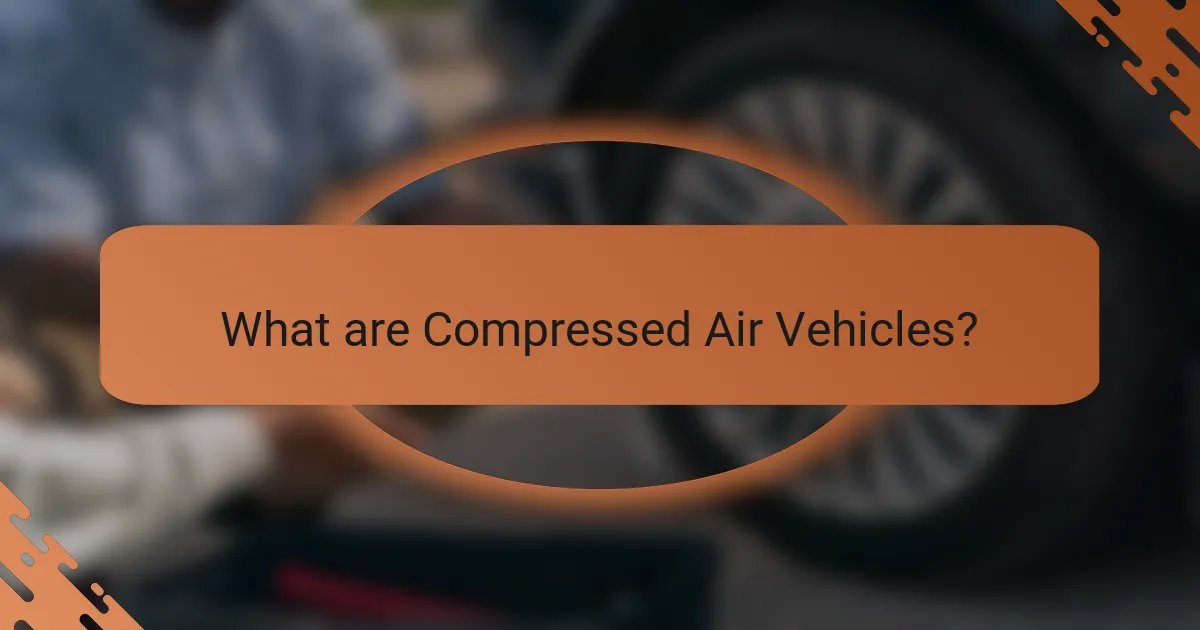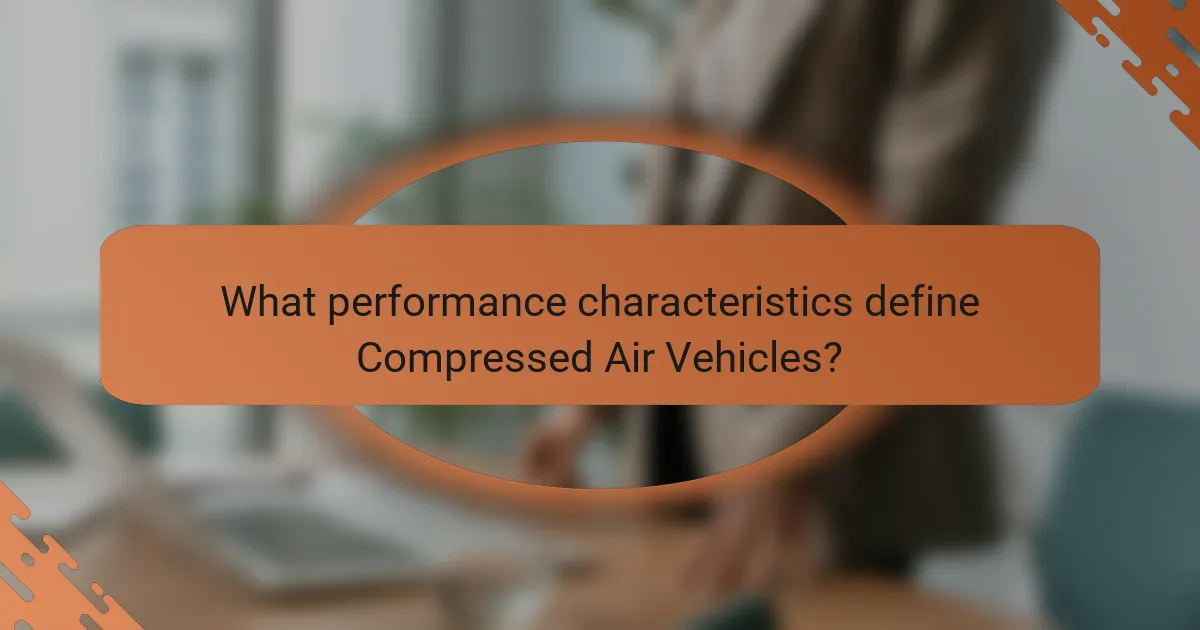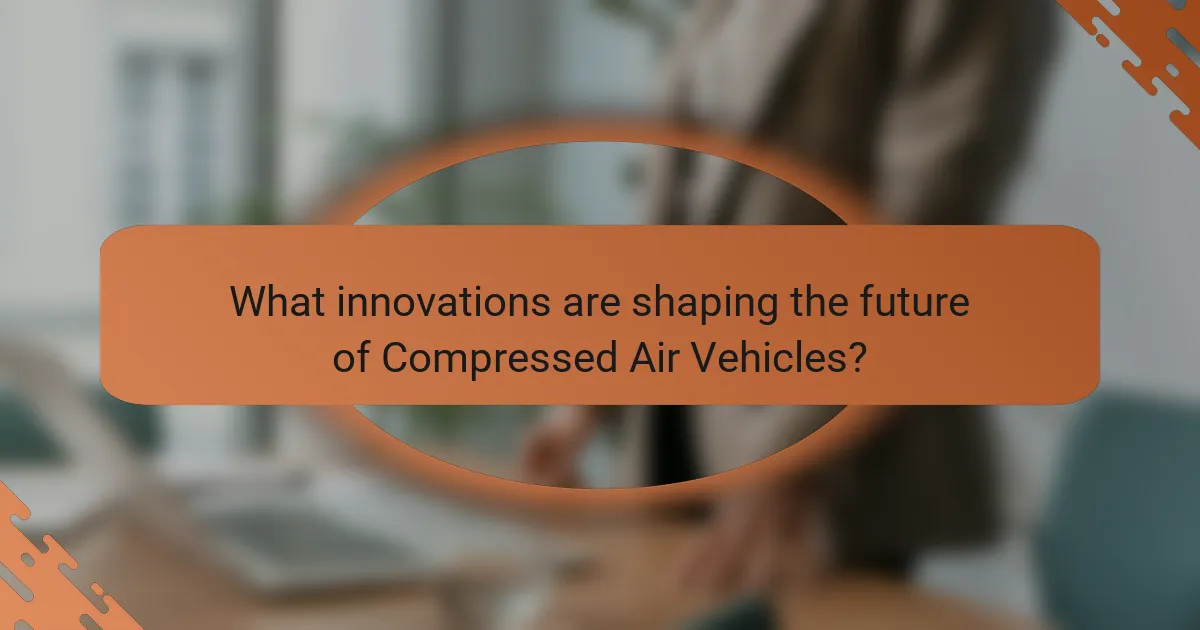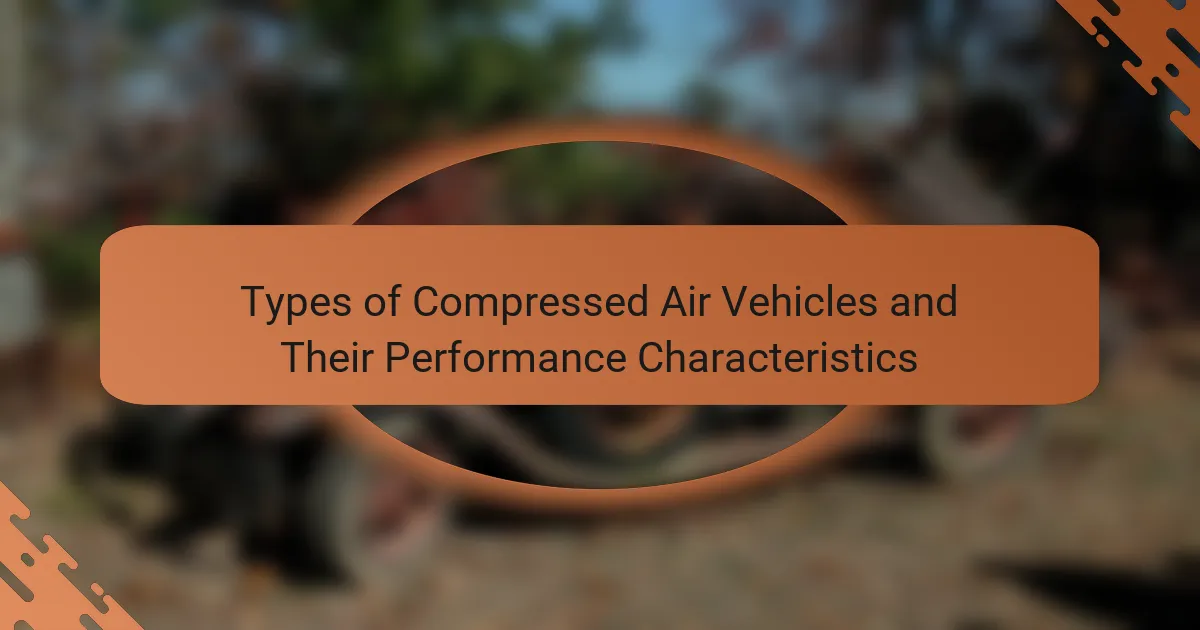Compressed Air Vehicles (CAVs) are innovative transportation solutions powered by compressed air stored in tanks, offering an environmentally friendly alternative to traditional fuel sources. This article explores the various types of CAVs, highlighting their performance characteristics such as energy efficiency, range, power output, and acceleration. Notably, CAVs can achieve distances of 100 to 200 kilometers on a full tank, demonstrating competitive torque for urban driving. The discussion also covers advancements in technology that enhance the efficiency and design of CAVs, including lightweight materials, improved air storage, and enhanced aerodynamics, positioning them as a viable option for sustainable transportation.

What are Compressed Air Vehicles?
Compressed air vehicles are vehicles powered by compressed air as a source of energy. They utilize compressed air stored in tanks to drive pistons or turbines, generating motion. This technology offers an alternative to traditional fuel sources. Compressed air vehicles are often seen as environmentally friendly due to their zero emissions during operation. The concept has been explored since the 19th century, with various prototypes developed over the years. Companies like MDI and others have created models demonstrating the viability of this technology. These vehicles typically feature lightweight designs to enhance efficiency. The range and performance can vary based on the amount of compressed air stored and the vehicle’s design.
How do Compressed Air Vehicles operate?
Compressed air vehicles operate by using compressed air as a source of propulsion. The vehicle stores compressed air in tanks. When the air is released, it expands and pushes against a piston or turbine. This movement generates mechanical energy, which drives the vehicle’s wheels. Compressed air vehicles often use a motor to convert this energy into motion. Efficiency is achieved by utilizing the energy stored in the compressed air. These vehicles produce zero emissions during operation, making them environmentally friendly. The technology is still under development for mainstream use.
What are the key components of a Compressed Air Vehicle?
The key components of a Compressed Air Vehicle include the air storage tank, the air motor, and the control system. The air storage tank holds compressed air, which serves as the energy source. The air motor converts the compressed air into mechanical energy for propulsion. The control system manages the flow of air from the tank to the motor. Additional components may include a pressure regulator and a frame. The pressure regulator ensures the air is delivered at the appropriate pressure for optimal performance. The frame provides structural support and houses all components. These elements work together to enable the vehicle to operate efficiently.
How does the air compression process work in these vehicles?
The air compression process in compressed air vehicles involves drawing in ambient air and compressing it to store energy. This process begins with an air intake system that captures air from the environment. The captured air is then directed into a compressor unit. The compressor uses mechanical energy to reduce the volume of the air, increasing its pressure.
As the air is compressed, its temperature also rises due to the principles of thermodynamics. Once the desired pressure is achieved, the compressed air is stored in a high-pressure tank. This stored energy can later be released to power the vehicle’s propulsion system.
The efficiency of the compression process is crucial for vehicle performance. Studies show that well-designed compressors can achieve pressure ratios of up to 10:1. This means that the compressed air can provide significant energy for driving the vehicle.
What are the different types of Compressed Air Vehicles?
Compressed air vehicles primarily include two types: compressed air cars and compressed air motorcycles. Compressed air cars utilize compressed air stored in tanks to power a piston engine. These vehicles are designed for urban commuting and short-distance travel. Compressed air motorcycles operate similarly, using compressed air to drive a lightweight engine. They are often designed for agility and speed. Both types aim to reduce fossil fuel dependence. They also aim to minimize emissions, contributing to environmental sustainability.
What are the classifications based on design and functionality?
Compressed air vehicles can be classified based on design and functionality into several categories. The main classifications include vehicle types such as buses, cars, and motorcycles. Each type is designed for specific applications and user needs. Additionally, functionality can categorize vehicles as either personal or commercial. Personal vehicles focus on individual use, while commercial vehicles are designed for transporting goods or multiple passengers. These classifications help in understanding the diverse applications of compressed air technology in the automotive sector.
How do these types differ in terms of application?
Compressed air vehicles differ in application based on their design and intended use. Some are optimized for urban environments, focusing on short-range travel. These vehicles often prioritize efficiency and compactness. Others are designed for longer distances, featuring larger tanks and more powerful motors. This design allows for greater speed and range. Additionally, some types are specifically tailored for industrial applications, capable of carrying heavy loads. Their robust construction supports high-performance demands. Each type serves distinct operational needs, influencing their performance characteristics.

What performance characteristics define Compressed Air Vehicles?
Compressed Air Vehicles (CAVs) are defined by their unique performance characteristics, including energy efficiency, range, and power output. Energy efficiency in CAVs is notable due to the use of compressed air as a clean energy source. These vehicles can achieve high efficiency rates, often exceeding traditional combustion engines.
The range of CAVs varies based on the air storage capacity. Typically, they can travel distances between 100 to 200 kilometers on a full tank of compressed air. Power output is another critical characteristic, with CAVs capable of delivering adequate torque for urban driving conditions.
Additionally, the acceleration of CAVs is competitive, often allowing them to reach speeds comparable to electric vehicles. The lightweight design of CAVs contributes to their agility and maneuverability.
Overall, these performance characteristics make Compressed Air Vehicles a viable alternative in the pursuit of sustainable transportation options.
How is the efficiency of Compressed Air Vehicles measured?
The efficiency of Compressed Air Vehicles (CAVs) is measured by analyzing their energy consumption and distance traveled. This includes assessing the amount of compressed air used to propel the vehicle over a specific distance. Efficiency is often expressed in terms of distance per unit of air volume, such as kilometers per liter of air.
Additionally, the performance metrics may involve evaluating the energy conversion efficiency from the compressed air to kinetic energy. Testing can be conducted under standardized conditions to ensure comparability. Factors such as vehicle weight, aerodynamics, and tire resistance also influence efficiency measurements.
Research studies often provide empirical data to validate these efficiency assessments. For instance, a study may report that a specific CAV achieves 100 kilometers on 10 liters of compressed air. This quantifiable data supports the evaluation of vehicle performance in real-world scenarios.
What metrics are used to evaluate performance?
Performance metrics for compressed air vehicles include speed, range, and efficiency. Speed measures how fast the vehicle can travel. Range indicates the maximum distance the vehicle can cover on a single charge of compressed air. Efficiency evaluates the energy consumption relative to distance traveled. Additional metrics may include acceleration, payload capacity, and operational cost. These metrics help assess overall vehicle performance in real-world conditions.
How does energy consumption impact performance characteristics?
Energy consumption directly influences the performance characteristics of compressed air vehicles. Higher energy consumption typically results in improved acceleration and speed. This is because more energy allows for greater air compression and propulsion power. Conversely, lower energy consumption can lead to reduced performance metrics, such as slower speeds and longer acceleration times.
Efficiency in energy consumption also affects range. Vehicles that consume energy more efficiently can travel further on the same amount of compressed air. For instance, studies show that optimizing energy use in compressed air systems can enhance vehicle range by up to 30%.
Additionally, energy consumption impacts the overall weight and design of the vehicle. A vehicle designed for higher energy efficiency may incorporate lighter materials, improving handling and agility. Thus, energy consumption is a critical factor in determining the performance characteristics of compressed air vehicles.
What are the advantages and disadvantages of Compressed Air Vehicles?
Compressed Air Vehicles (CAVs) have distinct advantages and disadvantages. One advantage is their environmentally friendly operation, producing zero emissions during use. This contributes to reduced air pollution and greenhouse gas emissions. CAVs can also be refueled quickly, often in a matter of minutes, similar to traditional vehicles. Additionally, they have lower operating costs compared to gasoline or diesel vehicles, primarily due to reduced fuel expenses.
However, CAVs also face significant disadvantages. One major limitation is their range, which is generally shorter than that of conventional vehicles. This limits their practicality for long-distance travel. Furthermore, the technology for CAVs is still in development, leading to limited availability and high initial costs. The energy density of compressed air is lower than that of fossil fuels, resulting in less energy efficiency. Lastly, the infrastructure for refueling CAVs is not widely established, which poses challenges for users.
What benefits do Compressed Air Vehicles offer compared to traditional vehicles?
Compressed Air Vehicles (CAVs) offer several benefits compared to traditional vehicles. They produce zero emissions during operation, contributing to cleaner air quality. CAVs utilize compressed air as a fuel source, which is abundant and renewable. This leads to reduced dependence on fossil fuels and lower operating costs. The vehicles typically have fewer moving parts, resulting in lower maintenance requirements. Additionally, CAVs can operate quietly, minimizing noise pollution in urban areas. Studies indicate that CAVs can achieve high energy efficiency, with some models converting over 90% of the energy from compressed air into motion. Overall, these advantages make CAVs an appealing alternative to conventional vehicles.
What are the limitations or challenges associated with their use?
Compressed air vehicles face several limitations and challenges. Their range is often limited due to the low energy density of compressed air. This results in shorter distances traveled compared to traditional fuel vehicles. Additionally, the efficiency of converting compressed air back into kinetic energy is relatively low. This inefficiency can lead to higher operational costs over time.
Moreover, the infrastructure for refueling compressed air vehicles is not widely available. This lack of infrastructure can hinder the adoption of such vehicles. Furthermore, the technology is still in development, leading to potential reliability issues. Finally, environmental factors, such as temperature, can affect the performance of compressed air systems.

What innovations are shaping the future of Compressed Air Vehicles?
Innovations shaping the future of compressed air vehicles include advancements in energy efficiency and design. New lightweight materials enhance vehicle performance and reduce energy consumption. Improved air storage technologies increase range and reduce refueling time. Enhanced aerodynamics contribute to better fuel efficiency. Innovations in control systems optimize air usage during operation. Integration of renewable energy sources for air compression is also emerging. Research indicates these advancements can significantly lower emissions and operational costs. The combination of these innovations positions compressed air vehicles as a viable alternative to traditional fuel-based vehicles.
How are advancements in technology improving performance?
Advancements in technology are significantly improving performance in compressed air vehicles. Enhanced materials are leading to lighter and stronger components. This reduction in weight directly increases the vehicle’s efficiency and speed. Improved energy storage systems allow for longer operational ranges. Advanced aerodynamics design reduces drag, optimizing fuel consumption. Innovations in control systems enable better handling and responsiveness. Real-time data analytics enhance performance monitoring and maintenance. These technological strides collectively result in superior performance metrics for compressed air vehicles.
What role does material science play in enhancing vehicle design?
Material science plays a crucial role in enhancing vehicle design by enabling the development of advanced materials that improve performance and safety. It facilitates the creation of lightweight materials, such as carbon fiber and aluminum alloys, which reduce vehicle weight and increase fuel efficiency. Enhanced materials also contribute to better crash safety through improved energy absorption properties. Additionally, material science allows for the integration of smart materials that can adapt to environmental changes, enhancing functionality. Research shows that vehicles utilizing advanced materials can achieve up to 30% better fuel efficiency. This improvement is critical in the context of compressed air vehicles, where weight reduction directly impacts energy consumption and performance.
How are smart technologies being integrated into Compressed Air Vehicles?
Smart technologies are being integrated into compressed air vehicles through advanced control systems and sensor technologies. These systems optimize vehicle performance by monitoring air pressure and adjusting power output in real-time. Sensors collect data on environmental conditions and vehicle status. This data is processed to enhance energy efficiency and safety. Additionally, smart technologies enable predictive maintenance, reducing downtime. Integration with mobile applications allows users to monitor vehicle performance remotely. Research indicates that these technologies can improve the overall efficiency of compressed air vehicles significantly.
What practical tips should users consider when operating Compressed Air Vehicles?
Users should ensure proper maintenance of compressed air vehicles. Regular checks on air pressure levels are essential. Users must inspect hoses and connections for leaks. Keeping the vehicle clean enhances performance and longevity. Users should follow manufacturer guidelines for operation and charging. Training on safety protocols is crucial to prevent accidents. Monitoring battery life and air tank levels ensures optimal performance. Lastly, users should avoid overloading the vehicle to maintain efficiency.
How can users maximize the efficiency of their Compressed Air Vehicle?
Users can maximize the efficiency of their Compressed Air Vehicle by maintaining optimal air pressure levels. Regularly check and adjust the air pressure to ensure it is within the recommended range. Efficient use of the vehicle also involves reducing weight by minimizing unnecessary cargo. This can enhance performance and extend range. Users should also maintain the vehicle’s components, including air tanks and valves, to prevent leaks. Keeping these parts in good condition ensures maximum air utilization. Additionally, driving at moderate speeds can improve overall efficiency. Fast acceleration and high speeds consume more compressed air. Lastly, users should plan routes to avoid excessive idling and stop-and-go traffic, which can waste energy.
What maintenance practices are essential for optimal performance?
Regular inspection of compressed air systems is essential for optimal performance. This includes checking for leaks, which can significantly reduce efficiency. Maintaining proper air pressure levels ensures that the vehicle operates within its designed parameters. Routine cleaning of filters prevents contamination and maintains airflow. Lubrication of moving parts reduces wear and extends the lifespan of components. Regularly scheduled maintenance checks can identify potential issues before they become serious problems. Following manufacturer guidelines for maintenance schedules ensures compliance and performance. Studies show that proper maintenance can improve performance by up to 30%.
Compressed air vehicles (CAVs) are innovative transportation solutions powered by compressed air, offering a zero-emission alternative to traditional fuel sources. This article explores the various types of CAVs, including cars and motorcycles, and delves into their performance characteristics such as energy efficiency, range, and power output. Key components, operational mechanisms, and the air compression process are examined, alongside the advantages and disadvantages of CAVs compared to conventional vehicles. Additionally, advancements in technology and material science that enhance CAV performance and efficiency are discussed, providing insights into the future of this sustainable transportation option.
